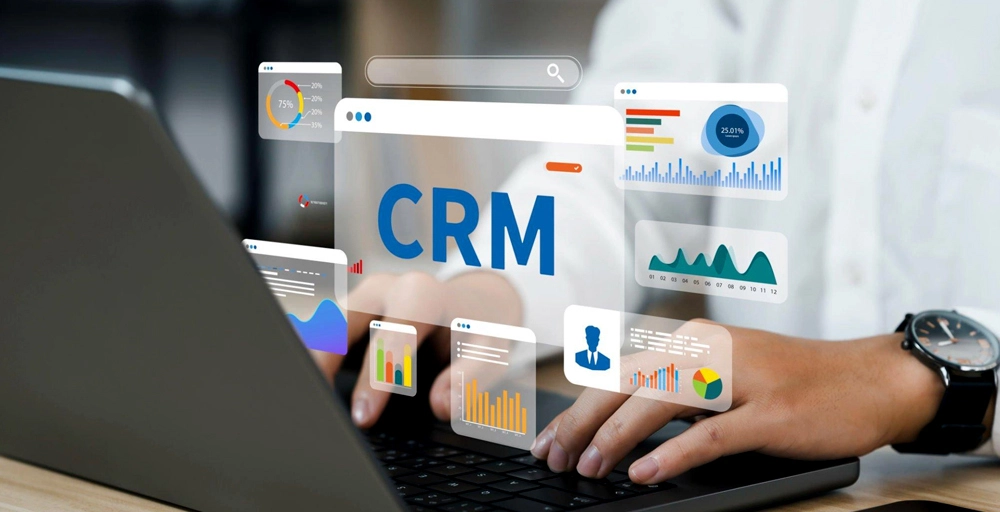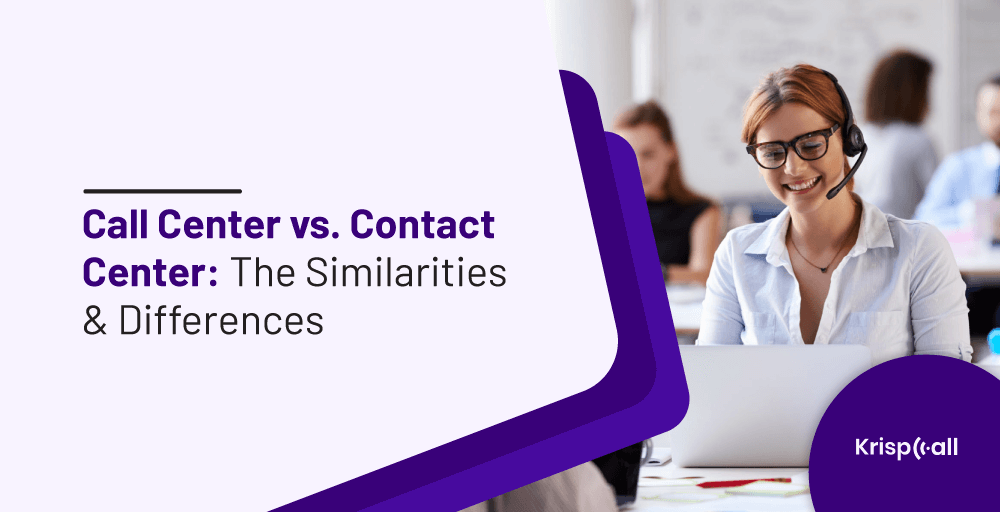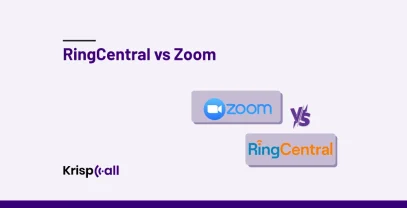Call center and contact center are two common business communication models that are often used interchangeably. Although they do have certain similarities, they are not the same at their core.
Understanding their differences is the vital step for providing a differentiated customer experience as per business needs. 💡
It’s no secret that customer expectations for customer service increases with time.
Though communication models help businesses keep up with increasing customer demand, not all customer service software is created equal.
This blog will give you a full idea on call center vs contact center, their benefits, key difference and similarities.
🔑 KEY POINTS
- The main difference between a call center and a contact center lies in the channels they utilize.
- Both the call center and contact center serve as a tool for customer service and predominantly engage phone channels.
- KrispCall offers you both the contact center and call center features.
Let’s get started! 👇
Call Center Vs Contact Center: Key differences
The main difference between a call center and a contact center lies in the channels they utilize. Call centers typically rely on traditional phone systems, while contact centers use various digital channels for customer communication.
There are several factors that set apart a call center from a contact center. Let’s have a detailed look at their differences.
1. Channel of communication
The key difference is the communication channel they use to interact with the customers. While call centers use telecommunication system for handling customer calls, contact center provides a multitude of options from phone to email, live chat, and social media.
Compared to phone as the only communication channel, multiple channels result in more rapid solutions delivery and better overall customer service.
Contact centers help to keep up with the increasing expectations of customers and provide customers with an easy way of raising their issues and seeking support from any platform of their preference.
2. Support type
Call centers and contact centers differ when it comes to the support type. While the support type of call center is reactive, the contact center is more predictive and proactive. That means call centers predict the complications that customers might face and proactively offer solutions before they run into some kind of trouble rather than assisting in running into problems.
The procedure can be followed in a call center, but it rarely works in practice. Outbound voice calls are often ineffective, considering how cell phone users are increasingly cautious about answering unfamiliar calls. But in the case of contact centers, agents can track the signs of frustration.
3. Automation
In a contact center, tickets are automatically routed to the most relevant agent based on keywords, previous customer histories, agent skills, etc. In addition, you can classify tickets and update their properties to track and close the cycle.
Furthermore, for the call center agents to resolve the customer’s query, a lengthy questionnaire routine had to be completed with the customer. However, Live agents can focus on resolving issues rather than starting completely from the beginning, thereby enhancing productivity.
4. Self-service management
The communication process is automated in both call centers and contact centers through IVR systems; however, there is a difference when an agent isn’t on hand. In some cases, the call center’s IVR may not be able to transfer the customer to a live agent. Customers don’t want to wait on hold to reach agents.
Customers can quickly raise the issue with Chatbot in contact centers since it can be embedded in the self-service portal. An agent can follow up later and offer a solution. By using this method, you ensure excellent customer service while reducing costs.
5. Customer categorization
Customer data collection by call centers involves a voice call that may result in misquotes or incorrectly spelled data. Moreover, you may not get the complete picture of the customer journey or the experience you are delivering.
A contact center’s software, however, combines data from multiple channels to create a single comprehensive view. Additionally, you can integrate your contact center software with CRM software for better customer insight.
What is a Call Center?
A call center is a centralized office or a hub that handle incoming and outgoing calls from existing or potential customers. It is for the customer conversations whose initial communication channels are primarily voice-based. So, a call center essentially uses telephones as its main communication channel.
Call centers can either be housed in a company’s office or outsourced to a service provider that specializes in handling calls.

The primary focus of the call center is to provide support and assistance to customers via telephone calls. For that purpose, some companies used to employ dedicated telephony hardware. But that trend is slowly turning obsolete these days. Nowadays, businesses are using call center software to handle calls more efficiently.
What are the types of Call Center Technologies?
There are two types of call center technologies mostly used by the business:
1. On-premise Call Centers
On-premise call centers are more traditional and rely on hardware. They require frequent updates every year, making it expensive call center technologies.
On-premise call centers use servers installed within the office premises that run dedicated software, hardware, and infrastructure. The dedicated communication server generally found on such configuration is PBX (Private Branch Exchange).
2. Cloud-based Call Centers
A cloud-based call center is a web-centric software platform designed to manage the inbound and outbound communications of a company. It is the exact opposite of an on-premise setup because the server here is online, and you don’t need physical equipment within the premises.
Since VoIP (Voice over Internet Protocol) is used for both inbound and outbound calls, your customer service agents can place calls and receive calls via the Internet rather than by telephone. They run using a cloud-hosted PBX where the specialized call center software provider is responsible for the whole service and infrastructure.
What are the benefits of a Call Center?
Call centers are often used for lead generation, lead nurturing, lead qualification, information gathering, cold calling, market research, outbound sales, and many more. Their benefits include:
- Decreased Costs
- Advanced Call Analytics
- Improved Security
- Team Collaboration
What is a Contact Center?
A contact center is a central point in an enterprise for handling customer communications and service across multiple channels, including phone, live chat, email, and social media.

Most companies integrate Customer Relationship Management (CRM) systems with their contact centers. Such integrations help to track, manage, and coordinate all the interactions between the business and its customer base.
Which industries use contact centers?
There is a vast scope and area of application of a contact center. But it didn’t quite come to mainstream use until recently. That’s because contact centers used to be exorbitant in the past. So, only large enterprises could afford and implement them in their business.
But with cloud-based contact centers on the rise, they have become affordable. So, these days, we can see it being implemented in several industries.
Following are some of the industries, where contact centers are used quite extensively.
- Healthcare
- Banking and Financial Institutions (BFIs)
- Telecommunications
- Retail stores
- Government
- Energy and Utilities
- Travel and Transportation Industry
- Food and Hospitality Industry
What are the benefits of Contact Centers
Incorporating contact centers offers several advantages to the business. Here are some of the important ones.
- Superior customer engagement and satisfaction
- Task Automation
- Unified lead information
- Enhanced brand image
Call Center Vs Contact Center: Which one is better?
Customer engagement and communication are crucial for businesses to move forward. So, to stay ahead in the game, businesses have to provide easy contact options to their customers managing maximum interactions possible.
Deciding between a call center and a contact center for business might be tricky due to their similarities.
Businesses need to consider various factors such as automation, CRM integration, skill-based routing, and software consolidation when deciding whether a call center or contact center is right for them.
Our top recommendation is KrispCall, which will make things easier for you. KrispCall is a cloud telephony platform, where you can get both the contact center and call center features in a single place.
What makes KrispCall the most interesting of all is its pricing starting at only $12/user/month. And as they are providing a free demo, you don’t have to spend a penny to get started.





